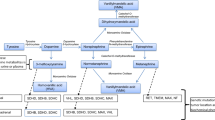Summary
The biogenesis of C19- and C21-steroids has been studied in tissue slices of a paraganglioma, of a pheochromocytoma and of human adrenal cortex using radioactive steroids. Slices of paraganglioma as well as of pheochromocytoma metabolise 17-hydroxyprogesterone to cortisone, cortisol, 11-deoxycortisol and testosterone. The rate of formation of these steroids, however, by the two tumours is 8–15 times less than that in normal adrenal cortex tissue. After incubation of dehydroepiandrosterone with tissue slices of paraganglioma and pheochromocytoma, 7α-hydroxydehydroepiandrosterone, 11β-hydroxy-4-androstene-3,17-dione and 4-androstene-3,17-dione were found as metabolites; testosterone was converted by both tissues to 4-androstene-3,17-dione. 17-Hydroxypregnenolone was converted to a small extent (1.7%) to dehydroepiandrosterone by slices of paranganglioma. These results show that enzymes of steroid biosynthesis (hydroxylases, oxidoreductases, δ4−5-isomerases, C17−20-desmolases) are present in both paraganglioma and pheochromocytoma.
Zusammenfassung
Die Biogenese von C19- und C21-Steroiden in Paragangliom-, Phäochromozytom- und normalem Nebennierengewebe des Menschen wurde mit Hilfe von Inkubationsversuchen radioaktiv markierter Steroide untersucht. Schnitte des Paraganglioms sowie des Phäochromozytoms wandeln 17-Hydroxyprogesteron enzymatisch zu Cortison, Cortisol, 11-Deoxycortisol sowie Testosteron um. Verglichen mit normalem Nebennierengewebe ist die Bildungsrate dieser Steroide jedoch 8–15mal geringer. Nach Inkubation von Dehydroepiandrosteron mit Paragangliom-oder Phäochromozytomgewebe entstehen 7α-Hydroxydehydroepiandrosteron, 11β-Hydroxy-4-androsten-3,17-dion und 4-Androsten-3,17-dion; Testosteron wird in beiden Geweben zu 4-Androsten-3,17-dion; umgewandelt. Paragangliomgewebe bildet aus 17-Hydroxypregnenolon in geringem Umfang Dehydroepiandrosteron (1,7%). Die Untersuchungen zeigen, daß sowohl im Paragangliom als auch im Phäochromozytom Enzyme der Steroidbiosynthese (Hydroxylasen, Oxidoreduktasen, δ4−5-Isomerasen, C17−20-Desmolasen) vorhanden sind.
Similar content being viewed by others
Literatur
Acevedo, H.F., Beering, S.C.: The metabolism of 4-14C-estradiol-17β by pheochromocytoma tissue. Steroids6, 531 (1965)
Ball, P., Knuppen, R., Haupt, M., Breuer, H.: Interactions between estrogens and catecholamines. III. Studies on the methylation of catechol estrogens, catechol amines and other catechols by the catechol-O-methyltransferase of humn liver. J. Clin. Endocr. Metabolism34, 736 (1972)
Breuer, H., Köster, G.: Interaction between oestrogens and neurotransmitters at the hypohysial-hypothalamic level. J. Steroid Biochem.5, 961 (1974)
Carballeira, A., Venning, E.H.: Conversion of steroids by chromaffin tissue. I. Studies with a pheochromocytoma. Steroids4, 329 (1964)
Cervós-Navarro, J., Bayer, J.M., Käser, H.: Ultrastrukturelle Differenzierung der Phäochromocytome. Virchows Arch. Abt. A Path. Anat.361, 51 (1973)
Cooper, D.Y., Rosenthal, O., Pileggi, V.J., Blakemore, W.S.: Stimulatory action of adrenal medulla and catecholamines upon hydroxylation of steroids by adrenocortical homogenates. Proc. Soc. Exp. Biol. Med.104, 52 (1960)
Hoffmann, W., Knuppen, R., Breuer, H.: Stoffwechsel von 4-14C Östron in verschiedenen Gewebepräparationen und Zellfraktionen der Nebenniere des Rindes. Z. Physiol. Chem.351, 387 (1970)
Meloni, C.R., Tucci, J., Canary, J.J., Kyle, L.H.: Cushing's syndrome due to bilateral adrenocortical hyperplasia caused by a benign adrenal medullary tumor. J. Clin. Endocr.26, 1192 (1966)
Mulrow, P.J., Cohn, G.L., Yesner, R.: Isolation of cortisol from a pheochromocytoma. Yale J. Biol Med.31, 363 (1959)
Williams, G.A., Crockett, C.L., Butler, W.S.S., Crispell, K.R.: The coexistence of pheochromocytoma and adrenocortical hyperplasia. J. Clin. Endocr.20, 622 (1960)
Author information
Authors and Affiliations
Rights and permissions
About this article
Cite this article
Rao, G.S., Rao, M.L., Breuer, H. et al. Biosynthese von C19- und C21-Steroiden im Paragangliom und Phäochromozytom des Menschen. Klin Wochenschr 56, 235–239 (1978). https://doi.org/10.1007/BF01477830
Received:
Accepted:
Issue Date:
DOI: https://doi.org/10.1007/BF01477830




